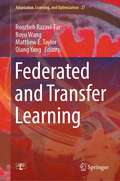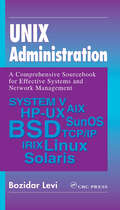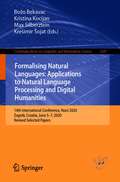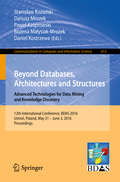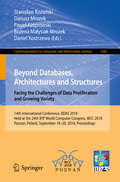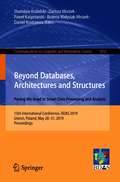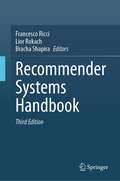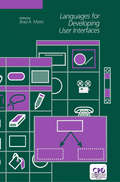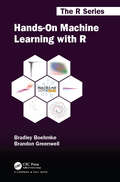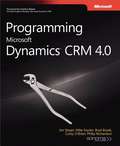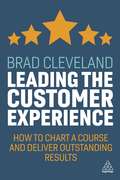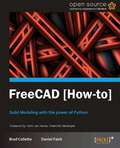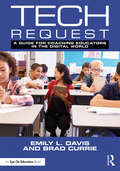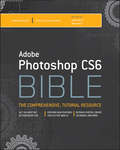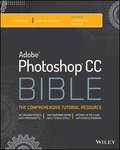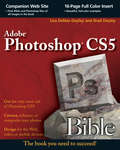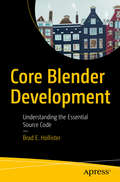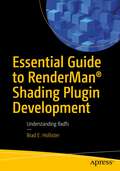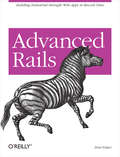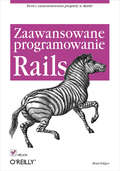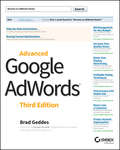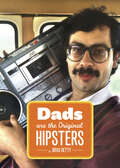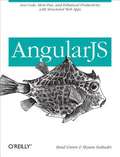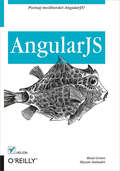- Table View
- List View
Federated and Transfer Learning (Adaptation, Learning, and Optimization #27)
by Qiang Yang Matthew E. Taylor Roozbeh Razavi-Far Boyu WangThis book provides a collection of recent research works on learning from decentralized data, transferring information from one domain to another, and addressing theoretical issues on improving the privacy and incentive factors of federated learning as well as its connection with transfer learning and reinforcement learning. Over the last few years, the machine learning community has become fascinated by federated and transfer learning. Transfer and federated learning have achieved great success and popularity in many different fields of application. The intended audience of this book is students and academics aiming to apply federated and transfer learning to solve different kinds of real-world problems, as well as scientists, researchers, and practitioners in AI industries, autonomous vehicles, and cyber-physical systems who wish to pursue new scientific innovations and update their knowledge on federated and transfer learning and their applications.
UNIX Administration: A Comprehensive Sourcebook for Effective Systems & Network Management (Internet and Communications)
by Bozidar LeviTo configure and maintain an operating system is serious business. With UNIX and its wide variety of "flavors," it can be especially difficult and frustrating, and networking with UNIX adds still more challenges.UNIX Administration: A Comprehensive Sourcebook for Effective Systems & Network Management is a one-stop handbook
Formalising Natural Languages: 14th International Conference, NooJ 2020, Zagreb, Croatia, June 5–7, 2020, Revised Selected Papers (Communications in Computer and Information Science #1389)
by Max Silberztein Božo Bekavac Kristina Kocijan Krešimir ŠojatThis book constitutes selected revised papers of the 14th International Conference, NooJ 2020, held Zagreb, Croatia, in June 2020. Due to the COVID-19 pandemic the conference was held online. NooJ is a linguistic development environment that allows linguists to formalize several levels of linguistic phenomena. NooJ provides linguists with tools to develop dictionaries, regular grammars, context-free grammars, context-sensitive grammars and unrestricted grammars as well as their graphical equivalent to formalize each linguistic phenomenon. The 20 full papers presented were carefully reviewed and selected from 68 submissions. The papers are organized in the following topics: Linguistic Formalization; Digital Humanities and Teaching with NooJ; Natural Language Processing Applications.
Beyond Databases, Architectures and Structures. Advanced Technologies for Data Mining and Knowledge Discovery: 12th International Conference, BDAS 2016, Ustroń, Poland, May 31 - June 3, 2016, Proceedings (Communications in Computer and Information Science #613)
by Dariusz Mrozek Stanisław Kozielski Paweł Kasprowski Bożena Małysiak-Mrozek Daniel KostrzewaThis book constitutes the refereed proceedings of the 12th International Conference entitled Beyond Databases, Architectures and Structures, BDAS 2016, held in Ustroń, Poland, in May/June 2016. It consists of 57 carefully reviewed papers selected from 152 submissions. The papers are organized in topical sections, namely artificial intelligence, data mining and knowledge discovery; architectures, structures and algorithms for efficient data processing; data warehousing and OLAP; natural language processing, ontologies and semantic Web; bioinformatics and biomedical data analysis; data processing tools; novel applications of database systems.
Beyond Databases, Architectures and Structures. Facing the Challenges of Data Proliferation and Growing Variety: 14th International Conference, BDAS 2018, Held at the 24th IFIP World Computer Congress, WCC 2018, Poznan, Poland, September 18-20, 2018, Proceedings (Communications in Computer and Information Science #928)
by Dariusz Mrozek Stanisław Kozielski Paweł Kasprowski Bożena Małysiak-Mrozek Daniel KostrzewaThis book constitutes the refereed proceedings of the 14th International Conference entitled Beyond Databases, Architectures and Structures, BDAS 2018, held in Poznań, Poland, in September 2018, during the IFIP World Computer Congress.It consists of 38 carefully reviewed papers selected from 102 submissions. The papers are organized in topical sections, namely big data and cloud computing; architectures, structures and algorithms for efficient data processing; artificial intelligence, data mining and knowledge discovery; text mining, natural language processing, ontologies and semantic web; image analysis and multimedia mining.
Beyond Databases, Architectures and Structures. Paving the Road to Smart Data Processing and Analysis: 15th International Conference, BDAS 2019, Ustroń, Poland, May 28–31, 2019, Proceedings (Communications in Computer and Information Science #1018)
by Dariusz Mrozek Stanisław Kozielski Paweł Kasprowski Bożena Małysiak-Mrozek Daniel KostrzewaThis book constitutes the refereed proceedings of the 15th International Conference entitled Beyond Databases, Architectures and Structures, BDAS 2019, held in Ustroń, Poland, in May 2019. It consists of 26 carefully reviewed papers selected from 69 submissions. The papers are organized in topical sections, namely big data and cloud computing; architectures, structures and algorithms for efficient data processing and analysis; artificial intelligence, data mining and knowledge discovery; image analysis and multimedia mining; bioinformatics and biomedical data analysis; industrial applications; networks and security.
Recommender Systems Handbook
by Lior Rokach Francesco Ricci Bracha ShapiraThis third edition handbook describes in detail the classical methods as well as extensions and novel approaches that were more recently introduced within this field. It consists of five parts: general recommendation techniques, special recommendation techniques, value and impact of recommender systems, human computer interaction, and applications. The first part presents the most popular and fundamental techniques currently used for building recommender systems, such as collaborative filtering, semantic-based methods, recommender systems based on implicit feedback, neural networks and context-aware methods. The second part of this handbook introduces more advanced recommendation techniques, such as session-based recommender systems, adversarial machine learning for recommender systems, group recommendation techniques, reciprocal recommenders systems, natural language techniques for recommender systems and cross-domain approaches to recommender systems. The third part covers a wide perspective to the evaluation of recommender systems with papers on methods for evaluating recommender systems, their value and impact, the multi-stakeholder perspective of recommender systems, the analysis of the fairness, novelty and diversity in recommender systems. The fourth part contains a few chapters on the human computer dimension of recommender systems, with research on the role of explanation, the user personality and how to effectively support individual and group decision with recommender systems. The last part focusses on application in several important areas, such as, food, music, fashion and multimedia recommendation. This informative third edition handbook provides a comprehensive, yet concise and convenient reference source to recommender systems for researchers and advanced-level students focused on computer science and data science. Professionals working in data analytics that are using recommendation and personalization techniques will also find this handbook a useful tool.
Languages for Developing User Interfaces
by Brad A. MyersThis book brings together a number of researchers and developers from industry and academia who report on their work. It is of interest to language designers and the creators of toolkits, UIMSs, and other user interface tools.
Hands-On Machine Learning with R (Chapman & Hall/CRC The R Series)
by Brad Boehmke Brandon M. GreenwellHands-on Machine Learning with R provides a practical and applied approach to learning and developing intuition into today&’s most popular machine learning methods. This book serves as a practitioner&’s guide to the machine learning process and is meant to help the reader learn to apply the machine learning stack within R, which includes using various R packages such as glmnet, h2o, ranger, xgboost, keras, and others to effectively model and gain insight from their data. The book favors a hands-on approach, providing an intuitive understanding of machine learning concepts through concrete examples and just a little bit of theory. Throughout this book, the reader will be exposed to the entire machine learning process including feature engineering, resampling, hyperparameter tuning, model evaluation, and interpretation. The reader will be exposed to powerful algorithms such as regularized regression, random forests, gradient boosting machines, deep learning, generalized low rank models, and more! By favoring a hands-on approach and using real word data, the reader will gain an intuitive understanding of the architectures and engines that drive these algorithms and packages, understand when and how to tune the various hyperparameters, and be able to interpret model results. By the end of this book, the reader should have a firm grasp of R&’s machine learning stack and be able to implement a systematic approach for producing high quality modeling results. Features: · Offers a practical and applied introduction to the most popular machine learning methods. · Topics covered include feature engineering, resampling, deep learning and more. · Uses a hands-on approach and real world data.
Programming Microsoft Dynamics® CRM 4.0
by Mike Snyder Jim Steger Brad Bosak Corey O'Brien Phil RichardsonGet answers to common questions about setting up the design environment and building custom solutions with Microsoft Dynamics CRM. Delve into core architecture, tools, and techniques, and learn how to exploit powerful customization features. Authored by industry-leading experts, this book shows how to deliver intelligent CRM solutions that meet the unique challenges and requirements of your business. Discover how to: Set up the development environment Enhance the product's APIs with your own code Execute business logic using plug-ins Build custom workflows that extend native workflow functions Create user-friendly integration with scripts and application extensions Code custom pages optimized for Microsoft Outlook with Offline Access Extend Microsoft Dynamics CRM using ASP.NET Create advanced Windows Workflow Foundation solutions Extend multilingual and multicurrency features Construct a custom security-access solution Get code samples on the Web.
Leading the Customer Experience: How to Chart a Course and Deliver Outstanding Results
by Brad ClevelandMany organizations and leaders struggle to respond effectively to fast-evolving customer expectations driven by innovations in products, services and technologies such as AI and mobile. Failing to build the necessary strategy, culture and processes, they suffer from high costs, dissatisfied customers and brand damage. The mandate to get customer experience right is real and urgent. Leading the Customer Experience is a guide to shaping experiences that win loyalty and deliver outstanding business results. It provides a bold, step-by-step approach that will get you and your team pointed in the right direction. And equipped to make sound decisions along the way. Leading the Customer Experience is easy to understand and imminently practical. It is based on the author's extensive experience both as a founding partner of one of the world's most influential customer management organizations, and his work with B2B and B2C organizations in the private and public sectors.The author's down-to-earth explanations cut through jargon and clutter, while stories and examples bring important principles to life. Leading the Customer Experience is relatable to anyone leading, managing or aspiring to better understand customer experience.
FreeCAD: Solid Modeling with the Power of Python
by Daniel Falck Brad ColletteWritten in cookbook style, this book offers many recipes to create objects, import and export data, create 3D solid objects. Each recipe contains step-by-step instructions followed by analysis of what was done in each task and other useful information. If you've been toying around with FreeCAD and want to have more control over your work flow then this book is for you. The reader needs to have basic knowledge of modeling.
Tech Request: A Guide for Coaching Educators in the Digital World
by Emily L. Davis Brad CurrieIn this much-needed book, experts Emily L. Davis and Brad Currie draw on their extensive experience in coaching and instructional technology and provide concrete, research-based strategies to help coaches in their day-to-day role. Whether you’re beginning a coaching initiative or looking for practical insights on coaching in a variety of settings, including in groups and one-to-one, you’ll find the resources you need to overcome challenges and grow your coaching skills. Topics include: The basics of tech coaching How to clarify on the expectations and objectives of your role Tips for recruiting teachers to work with you Guiding educators in planning and implementing meaningful technology integration How to plan and facilitate effective team coaching Strategies to gather and share data to communicate the impact of your coaching work How to stay ahead of the curve and keep learning for the future Every chapter includes practical tools, templates, and illustrative vignettes from the field to help you ensure the success of your technology coaching initiative. Join the conversation! Discuss the book and your coaching questions on Twitter with the hashtag #TechRequestEDU.
Adobe Photoshop CS6 Bible
by Brad Dayley Danae DayleyThe comprehensive, soup-to-nuts guide to Photoshop, fully updatedPhotoshop CS6, used for both print and digital media, is the industry leader in image-editing software. The newest version adds some exciting new features, and this bestselling guide has been revised to cover each of them, along with all the basic information you need to get started. Learn to use all the tools, including the histogram palette, Lens Blur, Match Color, and the color replacement tool, as well as keyboard shortcuts. Then master retouching and color correction, work with Camera Raw images, prepare photos for print or the web, and much more.Photoshop has the broadest user base of any professional-level graphics application, ranging from photo hobbyists to professionals in graphic design, publishing, video editing, animation, and broadcasting This comprehensive guide has what beginners need to know as well as intermediate-level information on key tools and procedures Features a 16-page full-color insert and a companion website with tutorials, including JPEG and PSD files of images from the book Covers image-editing basics, the File Browser, histogram palette, Lens Blur, Match Color, the color replacement tool, and customizable keyboard shortcuts Delves into techniques for working with Camera Raw images; how to retouch, color-correct, manipulate, and combine images; and all the new features and enhancements in the latest versionPhotoshop CS6 Bible is the one reference book every Photoshop user needs.
Photoshop CC Bible (Bible)
by Brad Dayley Lisa DaNae DayleyThe one reference book every Photoshop user needs! Adobe Photoshop is the industry leading image-editing software, and the newest version boasts exciting new features. This must-have comprehensive resource gets you started with the basics and then highlights the latest updates and revisions to the new Photoshop CC (Creative Cloud). You'll learn every aspect of Photoshop CC, from image editing basics to techniques for working with the histogram palette, Lens Blur, Match Color, and the color replacement tool, as well as keyboard shortcuts. • Explores retouching and color correction, working with Camera Raw images, preparing photos for print or the web, and much more • Details what beginners need to know and shares intermediate-level information on key tools and procedures • Delves into techniques for retouching, color-correcting, manipulating, combining images, as well as all the new features and enhancements in the latest version Photoshop CC Bible is essential reading for everyone from photo hobbyists to professionals in graphic design, publishing, video editing, animation, and broadcasting.
Photoshop CS5 Bible
by Lisa Danae Brad DayleyThe bestselling, comprehensive reference on Photoshop, fully updated to CS5. Photoshop is the gold standard for image-editing programs and is used by professional photographers, graphic designers, and Web designers as well as hobbyists. More than 300,000 copies of this comprehensive reference have been sold in previous editions; this edition is fully updated to cover Photoshop CS5's newest features and includes a 16-page full-color insert. Photoshop is the industry standard for image-editing software used in both print and digital media, with more than four million users worldwide This comprehensive guide covers beginning to advanced techniques, from learning your way around the windows and tools to working with Camera Raw images Covers retouching, color correcting, manipulating, and combining images; working with the File Browser, histogram palette, Lens Blur, and the color replacement tool; customizable keyboard shortcuts; how to create cutting-edge special effects for digital or film-based images, and much more This revised edition of Photoshop Bible is the reference tool that graphic designers, photographers, and Web designers will refer to many times over.
Core Blender Development: Understanding the Essential Source Code
by Brad E. HollisterLearn the essential source code of Blender and its unique build system. This book provides the inner workings of the Blender C-based source code, and will be indispensable for those wanting to contribute to this important open-source project.Blender is an open-source 3D modeling and rendering software package used in the production of assets for animated projects, 3D printing, games, and even scientific visualization. This book goes in depth and discusses the primary modules related to the GUI and the geometric modeling work. You'll start by learning how to reverse engineer geometric operators, and from there move on to the main features of the source code and how to apply them. When done, you'll have the necessary foundation for exploration in other modules of the Blender source code. Lack of software engineering knowledge, such as experience with large cross-platform code base, remains insurmountable for many new developers. While the Blender site includes much useful information, it is not detailed enough. Core Blender Development breaks down the barriers to entry for open-source development in 3-D modeling. What You’ll LearnFind the code for various functions and editors in BlenderTrack down bugs, and contribute new functionality to the Blender code baseExamine the .blend file and how it stores Blender stateUnderstand the Blender core code base beyond the community website documentationReview the explicit code traces and source files of descriptions of the code baseWho This Book Is ForPrimarily for novice to intermediate level developers and programmers with an interest in Blender, graphics, and visualization, who likely don’t have experience of reverse engineering a large code base.
Essential Guide to RenderMan® Shading Plugin Development: Understanding Bxdfs
by Brad E. HollisterUnderstand the fundamentals of Bxdf plugins for RenderMan® 21+, both the technical details and API architecture. The main goal of the book is to enable technical artists, hobbyists, and students in using the noncommercial (NCR), free RenderMan® edition. RenderMan® is an industry standard for rendering software. It has been used for every Pixar film to date and numerous other projects. RenderMan® 21, and all subsequent versions, use Monte Carlo path tracing. This change has necessitated the use of C++ plugins in place of the RenderMan Shader Language (RSL). Because of this, writing Bxdfs now requires knowledge of Monte Carlo integration, probability density functions, and the RenderMan® C++ API. Essential Guide to RenderMan® Shading Plugin Development specifically addresses writing RenderMan® C++ materials. It explores the mathematical models of representative Bxdfs while drawing parallels, when helpful, to earlier RSL implementations. It also includes an overview of Integrators, providing further context for modern RenderMan® programmable shading. What You Will LearnC++ development for BxdfsFundamentals of the rendering equationMonte Carlo integration Who Is This Book ForBeginner plugin writers for RenderMan®, such as technical artists, students, or hobbyists who may already have experience with RSL or another shader language. More experienced C++ developers without knowledge of RenderMan® or Monte Carlo path tracing will benefit from the content as well. While some prior experience in computer graphics is helpful, the book provides background and references for further study.
Advanced Rails
by Brad EdigerReady to go to the next level with Rails? From examining the parts of Ruby that make this framework possible to deploying large Rails applications, Advanced Rails offers you an in-depth look at techniques for dealing with databases, security, performance, web services and much more. Chapters in this book help you understand not only the tricks and techniques used within the Rails framework itself, but also how make use of ideas borrowed from other programming paradigms. Advanced Rails pays particular attention to building applications that scale -- whether "scale" means handling more users, or working with a bigger and more complex database. You'll find plenty of examples and code samples that explain: * Aspects of Ruby that are often confusing or misunderstood * Metaprogramming * How to develop Rails plug-ins * Different database management systems * Advanced database features, including triggers, rules, and stored procedures * How to connect to multiple databases * When to use the Active Support library for generic, reusable functions * Security principles for web application design, and security issues endemic to the Web * When and when not to optimize performance * Why version control and issue tracking systems are essential to any large or long-lived Rails project Advanced Rails also gives you a look at REST for developing web services, ways to incorporate and extend Rails, how to use internationalization, and many other topics. If you're just starting out with rails, or merely experimenting with the framework, this book is not for you. But if you want to improve your skills with Rails through advanced techniques, this book is essential.
Advanced Rails: Building Industrial-Strength Web Apps in Record Time
by Brad EdigerReady to go to the next level with Rails? From examining the parts of Ruby that make this framework possible to deploying large Rails applications, Advanced Rails offers you an in-depth look at techniques for dealing with databases, security, performance, web services and much more.Chapters in this book help you understand not only the tricks and techniques used within the Rails framework itself, but also how to make use of ideas borrowed from other programming paradigms. Advanced Rails pays particular attention to building applications that scale -- whether "scale" means handling more users, or working with a bigger and more complex database. You'll find plenty of examples and code samples that explain:Aspects of Ruby that are often confusing or misunderstoodMetaprogrammingHow to develop Rails plug-insDifferent database management systemsAdvanced database features, including triggers, rules, and stored proceduresHow to connect to multiple databasesWhen to use the Active Support library for generic, reusable functionsSecurity principles for web application design, and security issues endemic to the WebWhen and when not to optimize performanceWhy version control and issue tracking systems are essential to any large or long-lived Rails projectAdvanced Rails also gives you a look at REST for developing web services, ways to incorporate and extend Rails, how to use internationalization, and many other topics. If you're just starting out with rails, or merely experimenting with the framework, this book is not for you. But if you want to improve your skills with Rails through advanced techniques, this book is essential.
Rails. Zaawansowane programowanie
by Brad EdigerTwórz zaawansowane projekty w Rails!Jak zadba? o bezpiecze?stwo?Jak zapewni? wydajno?? Twojej aplikacji?Jak stworzy? i utrzyma? du?y projekt w Rails?Ruby on Rails przebojem wdar? si? na rynek szkieletów aplikacji internetowych. Stworzony w architekturze MVC z wykorzystaniem popularnego j?zyka Ruby, zosta? entuzjastycznie przyj?ty przez spo?eczno?? programistów. G?ówne za?o?enia autora tego projektu, Davida Heinemeiera Hanssona, to szybko??, ?atwo?? i przyjemno?? tworzenia kodu. Ruby on Rails jest dojrza?ym rozwišzaniem, wykorzystywanym przez wiele firm w aplikacjach internetowych, tworzonych pod kštem ich specyficznych potrzeb. Liczba aplikacji, które powsta?y z wykorzystaniem tego szkieletu, ?wiadczy o jego wysokiej jako?ci oraz niewštpliwie ma wp?yw na wzrost popularno?ci samego j?zyka Ruby."Rails. Zaawansowane programowanie" porusza te tematy, które Wy, programi?ci, lubicie najbardziej! Dzi?ki tej ksiš?ce dowiesz si?, w jaki sposób wykorzysta? gotowe wtyczki oraz jak stworzy? nowe. Nauczysz si? stosowa? zaawansowane funkcje bazy danych oraz pod?šcza? si? jednocze?nie do wielu baz. Po lekturze tego podr?cznika bez problemu zapewnisz swojej aplikacji najwy?szy poziom bezpiecze?stwa, optymalnš wydajno?? i skalowalno??. Autor wskazuje tutaj równie? niezwykle interesujšce kwestie, dotyczšce projektowania du?ych aplikacji, wykorzystania systemów kontroli wersji oraz utrzymywania w?a?ciwej struktury projektu.Przypomnienie i omówienie podstawowych elementów Ruby i RailsStosowanie ActiveSupport oraz RailTiesZastosowanie i projektowanie wtyczekZaawansowane wykorzystanie baz danychUwierzytelnianie za pomocš LDAPBezpieczne szyfrowanie hase?Bezpieczne przetwarzanie formularzy i danych u?ytkownika Zapewnienie wydajno?ciSkalowanie architekturyWykorzystywanie us?ug WebTworzenie wieloj?zycznych aplikacjiZarzšdzanie du?ymi projektamiU?ywanie systemów kontroli wersjiPoznaj wszystkie funkcje Ruby on Rails!
Advanced Google AdWords
by Brad GeddesMaster Google AdWords and get more out of your campaigns What's the secret to making every pay-per-click of your Google AdWords really pay? This must-have guide-written by a Google Advanced AdWords seminar instructor-shows you exactly how to apply advanced techniques and tactics for better results. Discover the best tools for keyword research, tips on crafting winning ad copy, advanced PPC optimization tricks, winning bidding strategies, and much more. If you manage AdWords PPC accounts, you won't want to miss this expert, detailed instruction. Covers the essential and advanced capabilities of Google AdWords Explores keyword research, PPC optimization strategies, the intricacies of Content Nation, how to interpret results and reports, and much more Provides busy marketers, consultants, PR professionals, Web developers, and others with an invaluable, step-by-step guide of advanced concepts Goes well beyond the basics and offers tips and tactics that you can immediately apply to your own campaigns Reinforces concepts through fascinating, real-world case studies Includes a $25 Google Adwords Gift Card for new customers If you've been seeking a practical, expert book on Google AdWords, one that goes well beyond the basics, Advanced Google AdWords is it!
Dads Are the Original Hipsters
by Brad GettyFrom the beloved blog comes this hilarious vintage photo collection of the OG hipsters, real dads in their glory days looking cooler than you’ll ever be.He listened to vinyl before you did. He drank whiskey before you did. He had a mustache before you did. Admit it: your dad was a hipster before you were! Based on the blog phenomenon of the same name, this book celebrates dads as the original hipsters. Vintage photos of real dads back in the day—in their short shorts and tight tees playing arcade games—accompany snarky captions that at once tip a cap to Dad’s glory days and poke fun at modern hipsters. Featuring tons of never-before-seen content, this book is perfect for dads, hipsters, and those who love to tease them!
AngularJS
by Shyam Seshadri Brad GreenDevelop smaller, lighter web apps that are simple to create and easy to test, extend, and maintain as they grow. This hands-on guide introduces you to AngularJS, the open source JavaScript framework that uses Model-view-controller (MVC) architecture, data binding, client-side templates, and dependency injection to create a much-needed structure for building web apps. Guided by two engineers who worked on AngularJS at Google, you'll walk through the framework's key features, and then build a working AngularJS app--from layout to testing, compiling, and debugging. You'll learn how AngularJS helps reduce the complexity of your web app. Dive deep into Angular's building blocks and learn how they work together Gain maximum flexibility by separating logic, data, and presentation responsibilities with MVC Assemble your full app in the browser, using client-side templates Use AngularJS directives to extend HTML with declarative syntax Communicate with the server and implement simple caching with the $http service Use dependency injection to improve refactoring, testability, and multiple environment design Get code samples for common problems you face in most web apps
AngularJS
by Shyam Seshadri Brad GreenPoznaj mo?liwo?ci AngularJS!AngularJS to hit ostatnich miesi?cy w aplikacjach internetowych, wniós? bowiem do kodu JavaScript powiew ?wie?o?ci oraz najlepsze praktyki znane z innych j?zyków programowania. Architektura MVC, wstrzykiwane zale?no?ci, wi?zanie danych to tylko niektóre z cech AngularJS. Je?eli zaintrygowa?y Ci? jego mo?liwo?ci i chcia?by? zg??bi? potencja? tego rozwi?zania, to trafi?e? na doskona?? ksi??k?!Napisana przez in?ynierów Google, pracuj?cych na co dzie? przy AngularJS, zawiera naj?wie?sze informacje z pierwszej r?ki. Si?gnij po ni? i przekonaj si?, jak szybko stworzy? ?atw? w utrzymaniu aplikacj?, korzystaj?c? z nowoczesnych wzorców, komunikuj?c? si? wydajnie z serwerem oraz pokryt? automatycznymi testami. Zdob?dziesz wiedz? na temat dyrektyw, kontrolerów oraz szablonów. Ponadto przekonasz si?, jak tworzy? aplikacje wspieraj?ce wiele j?zyków narodowych oraz w jaki sposób radzi? sobie z ciasteczkami (cookies). Ksi??ka ta jest doskona?? lektur? dla wszystkich osób chc?cych dzi?ki AngularJS zmieni? swoje podej?cie do tworzonego kodu JavaScript.Dzi?ki tej ksi??ce: poznasz technik? wi?zania danych wykorzystasz architektur? MVC w j?zyku JavaScript poznasz dost?pne zasi?gi w AngularJS opanujesz komunikacj? z serwerami swobodnie wykorzystasz mo?liwo?ci AngularJSTwój przewodnik po ?wiecie AngularJS!
